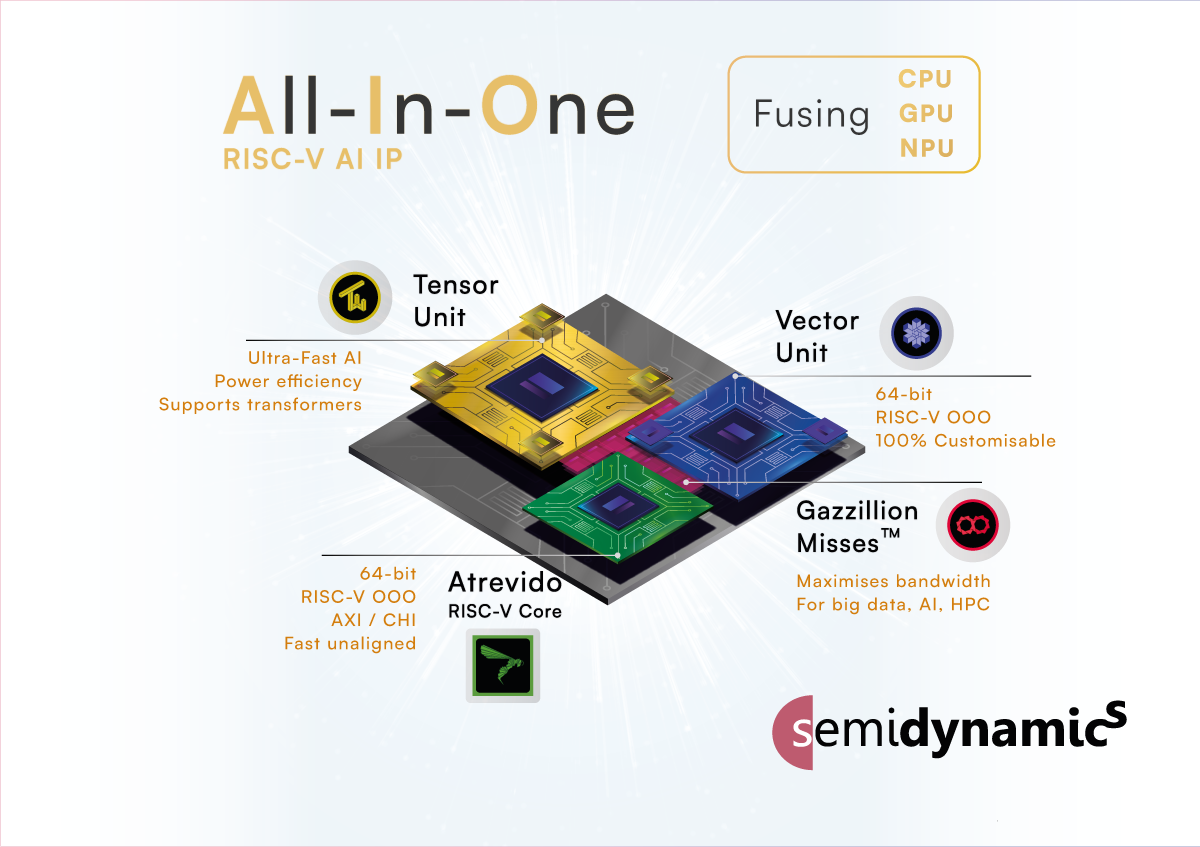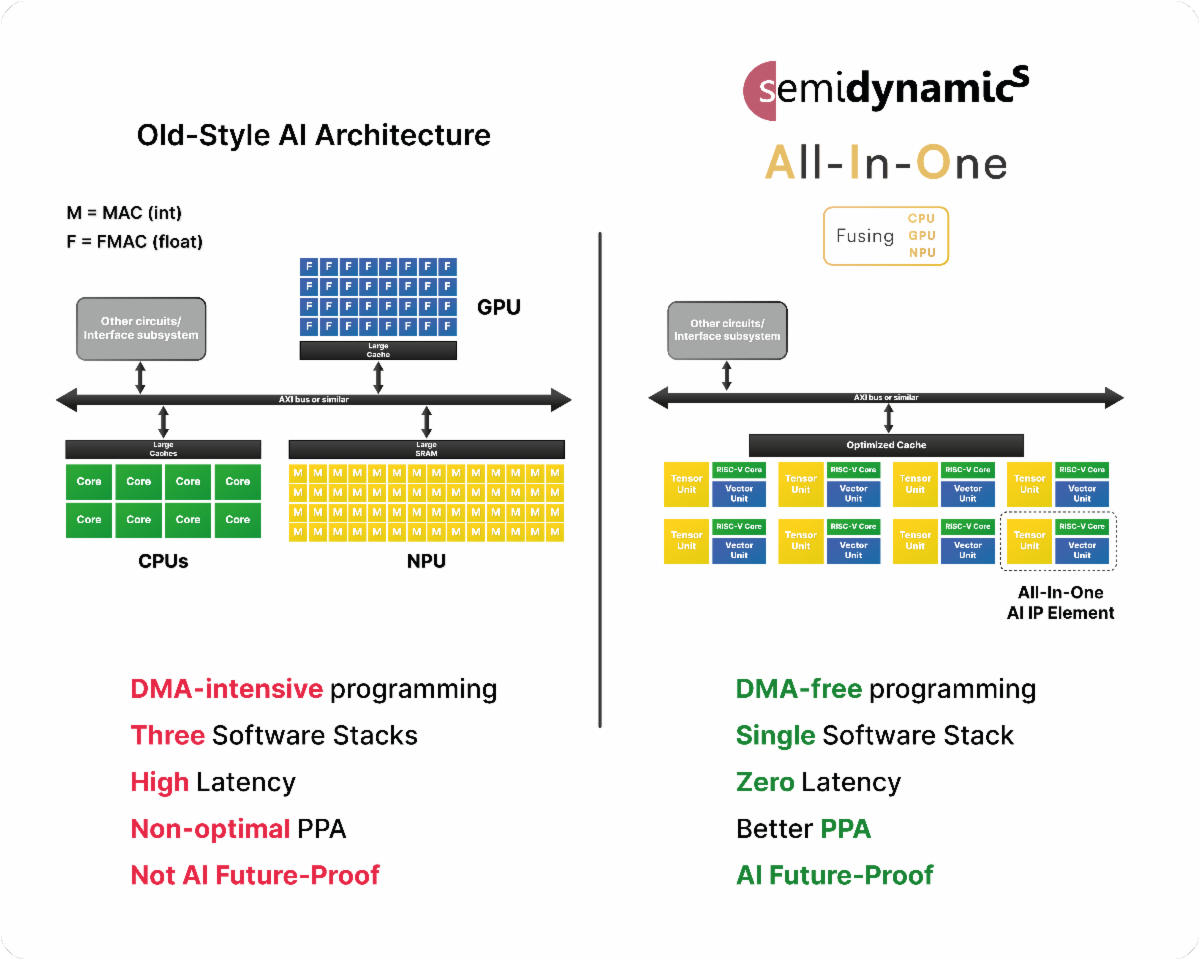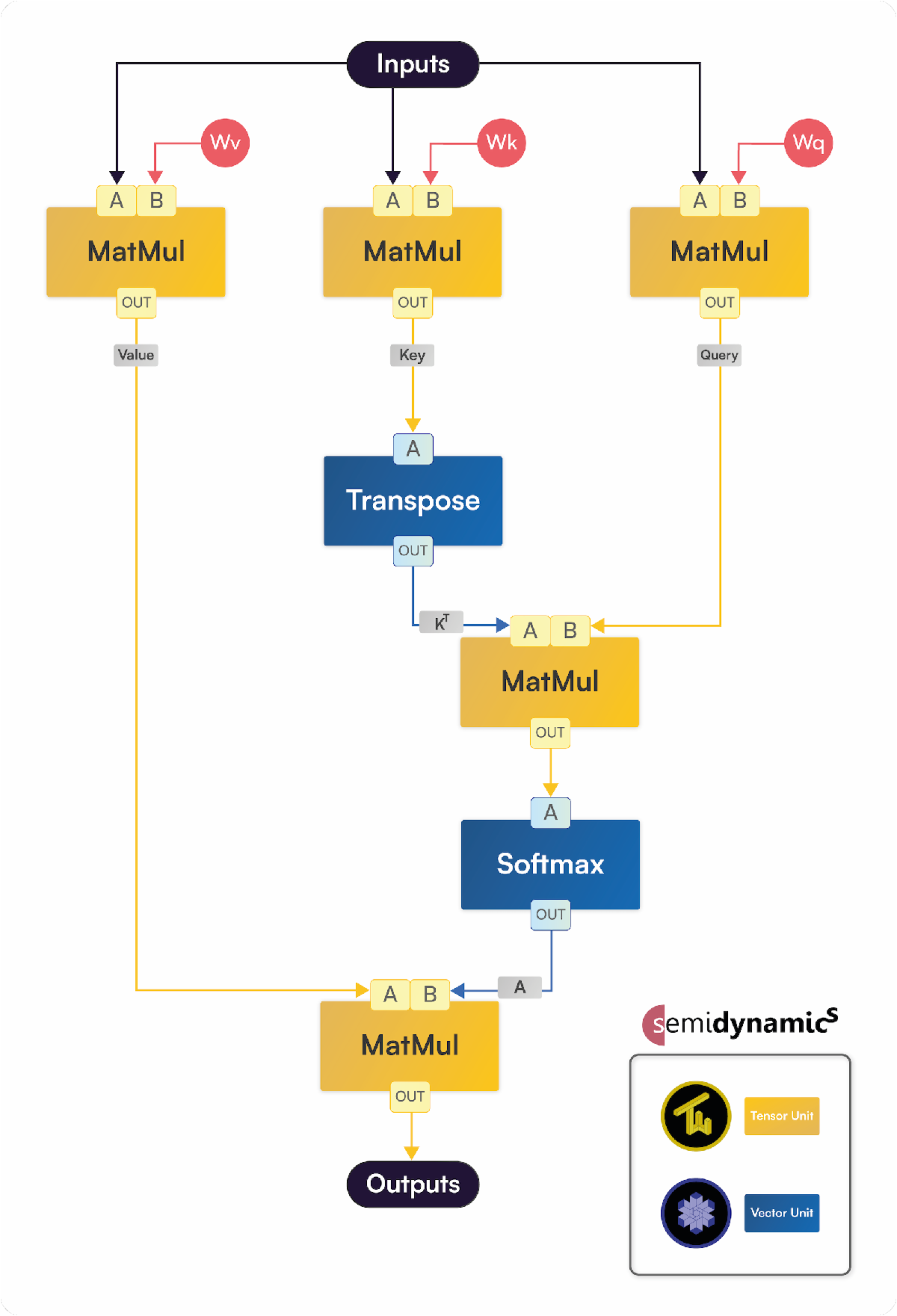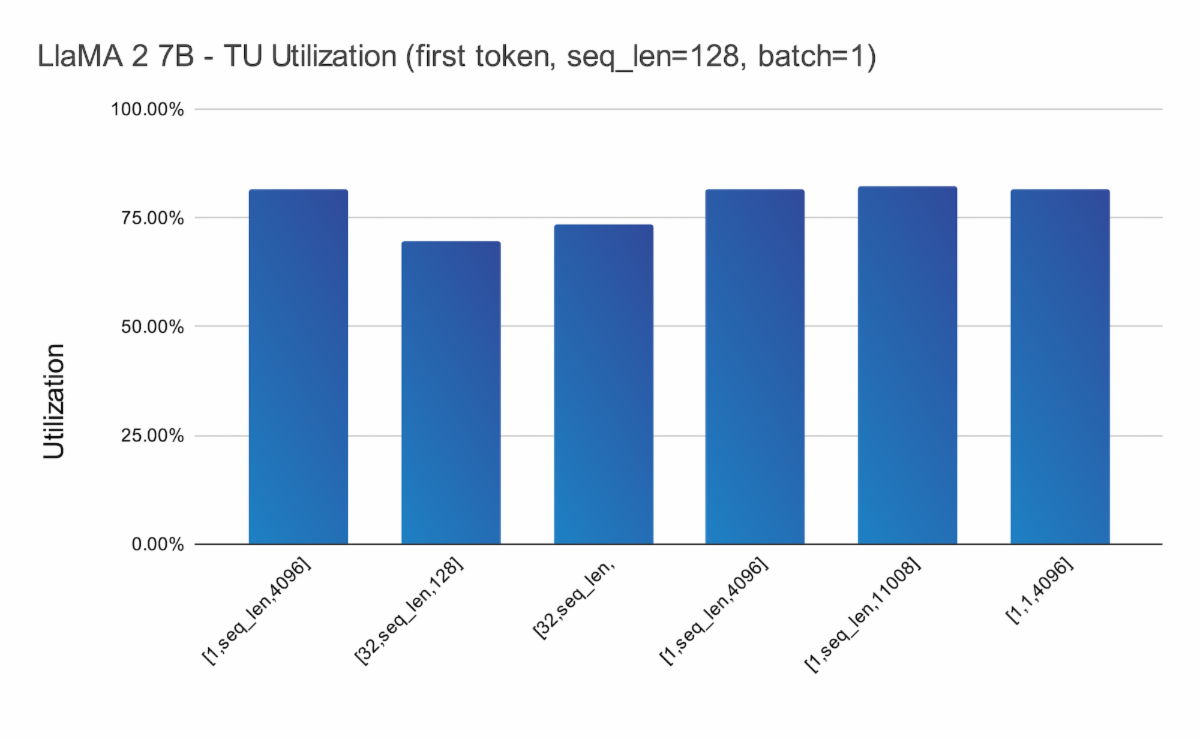欧洲RISC-V定制内核AI专家Semidynamics公布其运行LlaMA-2 70亿参数大语言模型 (LLM) 的‘一体式’ AI IP的张量单元效率数据。Semidynamics的CEO Roger Espasa解释道:“传统的人工智能设计使用三个独立的计算元件:CPU、GPU(图形处理器单元)和通过总线连接的NPU(神经处理器单元)。这种传统架构需要DMA密集型编程,这种编程容易出错、速度慢、耗能大,而且必须集成三种不同的软件栈和架构。而且,NPU是固定功能的硬件,无法适应未来尚未发明的AI算法。”

“相反,Semidynamics重新发明了AI架构,并将这三个要素整合到一个单一的、可扩展的处理元件中。我们将RISC-V内核、处理矩阵乘法的张量单元(扮演NPU的角色)和处理类似激活的计算的矢量单元(扮演GPU的角色)组合到一个全集成的一体式计算元件,如图1所示。我们的新架构无DMA,使用基于ONNX和RISC-V的单个软件堆栈,在三个元件之间提供直接的零延迟连接。因此,性能更高,功耗更低,面积更好,实现更容易编程的环境,降低整体开发成本。除此之外,因为张量和矢量单元由灵活的CPU直接控制,我们可以部署任何现有或未来的AI算法,为客户的投资提供巨大保护。
Barcelona, Spain – 25 June 2024. Semidynamics, the European RISC-V custom core AI specialist, has announced Tensor Unit efficiency data for its ‘All-In-One’ AI IP running a LlaMA-2 7B-parameter Large Language Model (LLM).
Roger Espasa, Semidynamics’ CEO, explained, “The traditional AI design uses three separate computing elements: a CPU, a GPU (Graphical Processor Unit) and an NPU (Neural Processor Unit) connected through a bus. This traditional architecture requires DMA-intensive programming, which is error-prone, slow, and energy-hungry plus the challenge of having to integrate three different software stacks and architectures. In addition, NPUs are fixed-function hardware that cannot adapt to future AI algorithms yet-to-be-invented.
“In contrast, Semidynamics has re-invented AI architecture and integrates the three elements into a single, scalable processing element. We combine a RISC-V core, a Tensor Unit that handles matrix multiplication (playing the role of the NPU) and a Vector Unit that handles activation-like computations (playing the role of the GPU) into a fully integrated, all-in-one compute element, as shown in Figure 1. Our new architecture is DMA-free, uses a single software stack based on ONNX and RISC-V and offers direct, zero-latency connectivity between the three elements. The result is higher performance, lower power, better area and a much easier-to-program environment, lowering overall development costs. In addition, because the Tensor and Vector Units are under the direct control of a flexible CPU, we can deploy any existing or future AI algorithm, providing great protection to our customer’s investments.”

图1 传统AI架构与Semidynamics的全新一体式集成解决方案对比
Figure 1 Comparison of traditional AI architecture to Semidynamics’ new All-In-One integrated solution
大语言模型 (LLM) 已成为AI应用的关键元件。LLM在计算上由自注意层主导,如图2详细所示。这些层包括五个矩阵乘法 (MatMul)、一个矩阵Transpose和一个SoftMax激活函数,如图2所示。在Semidynamics的一体式解决方案中,张量单元 (TU) 负责矩阵乘法,而向量单元(VU)可以有效地处理Transpose和SoftMax。由于张量和矢量单元共享矢量寄存器,因此可以在很大程度上避免昂贵的内存复制。因此,在将数据从MatMul层传输到激活层以及从激活层传回时,实现零延迟和零能耗。为了保持TU和VU持续繁忙,必须有效地将权重和输入从存储器提取到矢量寄存器中。为此,Semidynamics的Gazzillion™ Misses技术提供了前所未有的数据迁移能力。通过支持大量的运行中缓存未命中,可以提前提取数据,从而提高资源利用率。而且,Semidynamics的定制张量扩展包括为获取和转换2D贴片而优化的新矢量指令,极大地改进了张量处理。
Large Language Models (LLMs) have emerged as a key element of AI applications. LLMs are computationally dominated by self-attention layers, shown in detail in Figure 2. These layers consist of five matrix multiplications (MatMul), a matrix Transpose and a SoftMax activation function, as shown in Figure 2. In Semidynamics’ All-In-One solution, the Tensor Unit (TU) takes care of matrix multiplication, whereas the Vector Unit (VU) can efficiently handle Transpose and SoftMax. Since the Tensor and Vector Units share the vector registers, expensive memory copies can be largely avoided. Hence, there is zero latency and zero energy spent in transferring data from the MatMul layers to the activation layers and vice versa. To keep the TU and the VU continuously busy, weights and inputs must be efficiently fetched from memory into the vector registers. To this end, Semidynamics’ Gazzillion™ Misses technology provides unprecedented ability to move data. By supporting a large number of in-flight cache misses, data can be fetched ahead-of-time yielding high resource utilization. Furthermore, Semidynamics’ custom tensor extension includes new vector instructions optimized for fetching and transposing 2D tiles, greatly improving tensor processing.

图2 LLM的自注意层
Figure 2 Attention Layer in LLM
Semidynamics在其一体式元件上运行了完整的LlaMA-2 70亿参数模型(BF16权重),使用 Semidynamics的ONNX运行时执行提供程序,并计算出模型中所有MatMul层的张量单元的利用率。结果如图3所示。将结果聚在一起,并按照A张量形状演示组织。LlaMA-2共有6种不同形状,如图3中的x轴标签所示。我们从中可以看出,大多数形状的利用率都在80%以上,与其他架构形成鲜明对比。结果是在最具挑战性的条件下收集的,即一批1和首个词元计算。为了补充这些数据,图4显示了大矩阵尺寸的张量单元效率,以展示张量单元和Gazzillion™技术的综合效率。图4标注了A+B矩阵大小。我们可以从中看出,随着矩阵的N、M、P维度中的元件数量的增加,总大小(以MB为单位)迅速超过任何可能的缓存/暂存区。该图表值得注意的是,无论矩阵的总大小如何,性能都稳定在略高于70%的水平。这一令人惊讶的结果要归功于Gazzilion技术能够在主存储器和张量单元之间维持较高的流数据速率。
Semidynamics has run the full LlaMA-2 7B-parameter model (BF16 weights) on its All-In-One element, using Semidynamics’ ONNX Run Time Execution Provider, and calculated the utilization of the Tensor Unit for all the MatMul layers in the model. The results are shown in Figure 3. The results are aggregated and presented organized by the A-tensor shape. There are a total of 6 different shapes in LlaMA-2, as shown in the x-axis labels in Figure 2. As it can be seen, utilization is above 80% for most shapes, in sharp contrast with other architectures. Results are collected in the most challenging conditions, i.e., with a batch of 1 and for the first-token computation. To complement this data, Figure 4 presents the Tensor Unit efficiency for large matrix sizes, to demonstrate the combined efficiency of the Tensor Unit and the Gazzillion™ technology. Figure 4 is annotated with the A+B matrix size. One can see that as the number of elements in the N, M, P dimensions of the matrix increase, the total size in MBs quickly exceeds any possible cache/scratchpad available. The noteworthy aspect of the chart is that the performance is stable slightly above 70%, irrespective of the total size of the matrices. This quite surprising result is thanks to the Gazzillion technology being capable of sustaining a high streaming data rate between main memory and the Tensor Unit.

图3张量A形组织的LlaMA-2张量单元效率
Figure 3 LlaMA-2 Tensor Unit efficiency organized by Tensor-A shape

图4不同矩阵大小的8位(左侧)和16位矩阵(右侧)的张量单元利用率
Figure 4 Tensor Unit utilization for 8-bit (left side) and 16-bit matrices (right side) for different matrix sizes
Espasa总结说:“我们的全新一体式AI IP不仅具有出色的人工智能性能,而且编程也更容易,因为现在只有一个软件堆栈,而不是三个。开发人员可以使用已知的RISC-V堆栈,而且他们不必担心软件管理的本地SRAM或DMA。此外,Semidynamics提供了针对一体式AI IP优化的ONNX运行时,这使程序员能够轻松运行他们的ML模型。因此,我们的解决方案在程序员友好性和易于集成到新SOC设计方面迈出了一大步。借助一体式AI IP,我们的客户将能够以更好、更容易编程的硅的形式将所有这些好处传递给他们的客户、开发人员和用户。”
“此外,我们的一体式设计对未来AI/ML算法和工作负载的变化具有充分的弹性。对于启动一个在几年内不会上市的硅片项目的客户来说,这是一个巨大的风险保护。知道当您的硅片进入批量生产时您的AI IP仍然是相关的,这是我们技术的一个独特优势。”
2016年成立于西班牙巴塞罗那,Semidynamics®是唯一完全可定制的RISC-V处理器IP提供商,专业提供高带宽、高性能内核,其矢量单元和张量单元面向机器学习和人工智能应用。我公司为私人公司,是RISC-V联盟的战略成员。
 芯耀
芯耀




 1043
1043

 下载ECAD模型
下载ECAD模型





